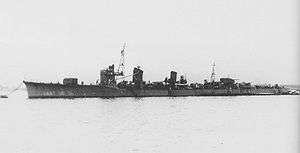Japanese destroyer Tanikaze (1940)
 Tanikaze in April 1941 | |
| History | |
|---|---|
| Name: | Tanikaze |
| Launched: | 1 November 1940 |
| Commissioned: | 25 April 1941 |
| Struck: | 10 August 1944 |
| Fate: | Sunk in action, 9 June 1944 |
| General characteristics | |
| Class and type: | Kagerō-class destroyer |
| Displacement: | 2,490 long tons (2,530 t) |
| Length: | 118.5 m (388 ft 9 in) |
| Beam: | 10.8 m (35 ft 5 in) |
| Draft: | 3.8 m (12 ft 6 in) |
| Speed: | 35 knots (40 mph; 65 km/h) |
| Complement: | 240 |
| Armament: |
|
Tanikaze (谷風, Valley Wind) was one of 19 Kagerō-class destroyers built for the Imperial Japanese Navy during the 1930s.
Design and description
The Kagerō class was an enlarged and improved version of the preceding Asashio class. Their crew numbered 240 officers and enlisted men. The ships measured 118.5 meters (388 ft 9 in) overall, with a beam of 10.8 meters (35 ft 5 in) and a draft of 3.76 meters (12 ft 4 in).[1] They displaced 2,065 metric tons (2,032 long tons) at standard load and 2,529 metric tons (2,489 long tons) at deep load.[2] The ships had two Kampon geared steam turbines, each driving one propeller shaft, using steam provided by three Kampon water-tube boilers. The turbines were rated at a total of 52,000 shaft horsepower (39,000 kW) for a designed speed of 35 knots (65 km/h; 40 mph). The ships had a range of 5,000 nautical miles (9,300 km; 5,800 mi) at a speed of 18 knots (33 km/h; 21 mph).[3]
The main armament of the Kagerō class consisted of six Type 3 127-millimeter (5.0 in) guns in three twin-gun turrets, one superfiring pair aft and one turret forward of the superstructure. They were built with four Type 96 25-millimeter (1.0 in) anti-aircraft guns in two twin-gun mounts, but more of these guns were added over the course of the war. The ships were also armed with eight 610-millimeter (24.0 in) torpedo tubes for the oxygen-fueled Type 93 "Long Lance" torpedo in two quadruple traversing mounts; one reload was carried for each tube.[2] Their anti-submarine weapons comprised 16 depth charges.[3]
Construction and career
In June 1942 the ship participated in the Battle of Midway where she was damaged by air attacks. On 5 June, the day after the main Battle of Midway, Tanikaze, was sent by Admiral Nagumo to ensure the last IJN aircraft carrier Hiryū had actually sunk, to scuttle it if necessary, and collect any survivors.
Tanikaze had the unfortunate luck of being seen by 61 US Dauntless dive bombers sent to destroy Hiryū if it was still afloat. After they were unable locate the aircraft carrier (it had sunk about an hour earlier), the dive bombers turned back to simultaneously attack the hapless Japanese destroyer, since their bombs needed to be jettisoned before landing anyway. Through aggressive maneuvering (zig zagging) by the ship's Captain Motomi Katsumi, not one of the 61 dive bombers managed a direct hit. The log of Tanikaze reported "Medium damage from air attack with 6 dead on June 5", but the ship survived.
Later that year Tanikaze was busy with transport missions to Guadalcanal and in first months of 1943 she aided in the evacuation of Japanese forces from the island.
On 9 June 1944, Tanikaze was torpedoed and sunk by the submarine USS Harder in Sibutu Passage near Tawitawi, 90 miles (140 km) southwest of Basilan (05°42′N 120°41′E / 5.700°N 120.683°E). 114 crew members were killed, while 126 survivors, including her commander Lieutenant Commander Ikeda, were rescued by the destroyer Urakaze, which five months later would be sunk by the submarine USS Sealion with all hands, including all survivors from Tanikaze.
Notes
References
- Chesneau, Roger, ed. (1980). Conway's All the World's Fighting Ships 1922–1946. Greenwich, UK: Conway Maritime Press. ISBN 0-85177-146-7.
- Jentschura, Hansgeorg; Jung, Dieter & Mickel, Peter (1977). Warships of the Imperial Japanese Navy, 1869–1945. Annapolis, Maryland: United States Naval Institute. ISBN 0-87021-893-X.
- Whitley, M. J. (1988). Destroyers of World War 2. Annapolis, Maryland: Naval Institute Press. ISBN 0-87021-326-1.
External links
- CombinedFleet.com: Kagero-class destroyers
- CombinedFleet.com: Tanikaze history
- Googlebooks.com: The Battle of Midway
Coordinates: 05°42′N 120°41′E / 5.700°N 120.683°E